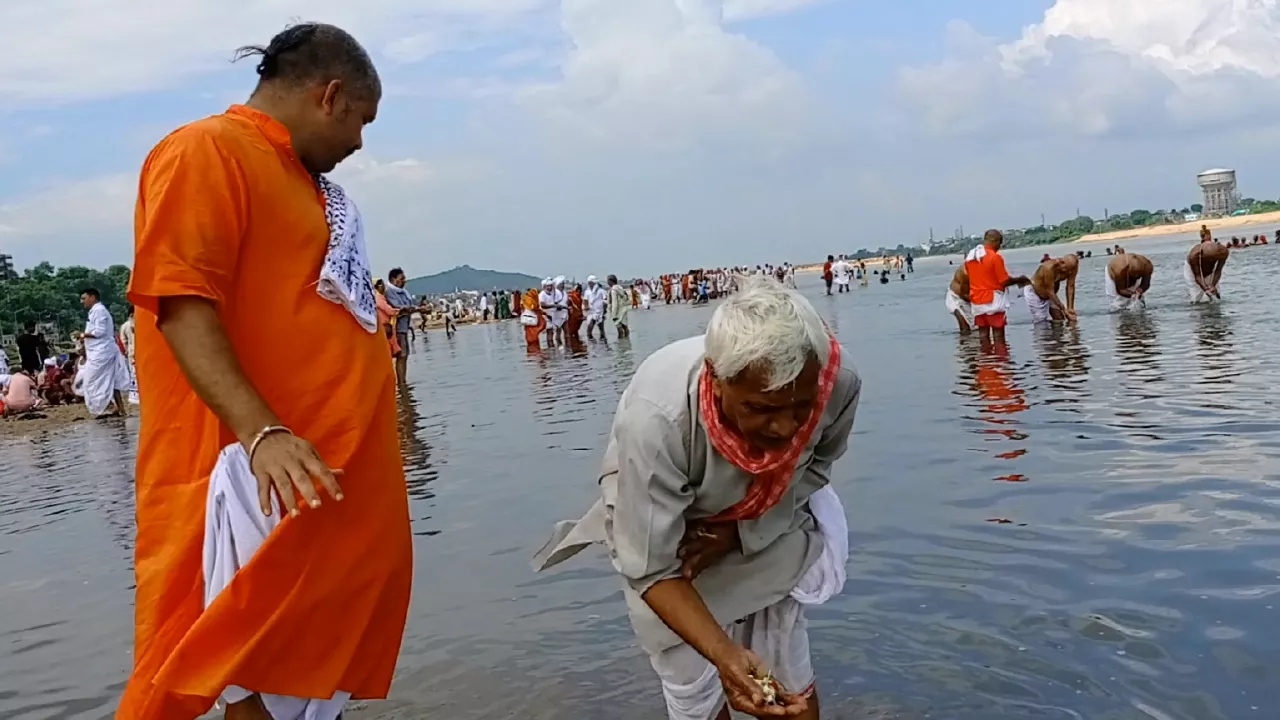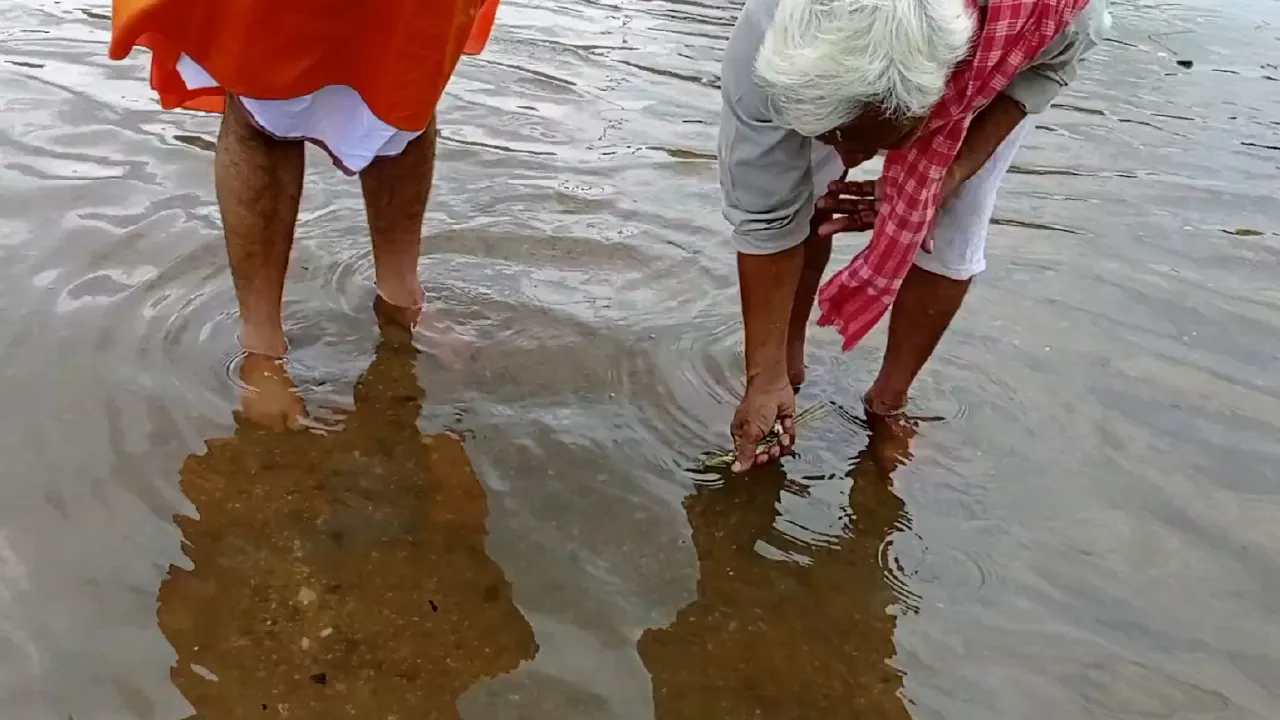Namaste,
The sanctity of rivers and the most auspicious locations for offering libations to our ancestors (Pitṛs). Ah, indeed, the waters of Bharatavarsha are not mere streams; they are pathways to the divine, imbued with spiritual power, as extolled endlessly in our revered Puranas.
To understand the Sacred locations for Tarpan, we must first delve into why rivers themselves hold such a hallowed place in the heart of Sanatana Dharma. Like the Agni Purana, Skanda Purana, Varaha Purana, Garuda Purana, Brahma Purana, Padma Purana, and Siva Purana, share some insights.
Top Sacred Locations for Tarpan: Where to Go Based on the Puranas
Water (Jala) is life. It cleanses, sustains, and flows, mirroring the very nature of time and existence. But in Bharat, our rivers are far more than just physical bodies of water; they are considered goddesses, mothers, and conduits to liberation (mokṣa). Their sanctity permeates our culture, our rituals, and our understanding of the cosmos.

The Divine Essence of Rivers: Why Are They Considered Holy?
The Puranas offer several profound reasons for the extraordinary reverence accorded to rivers:
- Celestial Origins: Many of our most sacred rivers are believed to originate not merely from earthly mountains but from celestial realms, carrying divine purity. The Brahma Purana (Part 1) declares that the rivers flowing through sacred regions descend directly from heaven (svarga) and are inherently holy. The Skanda Purana (Part 7) narrates how the mighty Ganga issued forth from the very toe of Lord Hari (Vishnu), and the Sarayu from His other foot, forever marking them with divine touch.
- Association with Deities: Rivers are often personified as goddesses or intrinsically linked to major deities. Yamuna is the noble daughter of the Sun-god (Surya), as mentioned in the Skanda Purana (Part 13). The Godavari is described as exceedingly holy and dear to Lord Shiva in the Siva Purana (Part 1) and Brahma Purana (Part 4). The Narmada (Reva) is a particular favourite of Mahadeva (Shiva), according to the Skanda Purana (Part 10). Bathing in or offering rites at such rivers is akin to being in the direct presence of divinity.
- Unmatched Purifying Power (Pāpa-Nāśinī): Perhaps the most celebrated quality of sacred rivers is their immense power to wash away sins (pāpa) and grant purity. The Agni Purana asserts that bathing in the Ganga, anywhere along its course, prevents rebirth in lower realms (hell). The Skanda Purana (Part 20) proclaims that merely plunging into the Sarasvati river brings happiness and ends misery. The Varaha Purana states emphatically that sins vanish simply by bathing in, drinking, carrying, speaking of, thinking about, hearing about, or even seeing the waters of certain holy rivers and places. This purifying quality makes them ideal locations for rituals aimed at cleansing karmic impurities, both for ourselves and our ancestors.
- Bestowers of Blessings and Liberation: Sacred rivers are not just purifiers; they are active bestowers of merit (puṇya), blessings, and ultimately, liberation. The Agni Purana lists Ganga, Godavari, Kaveri, Narmada, Tapi, Payosni, and Reva as rivers that bestow all desired fruits (sarva-phala-pradā). The Varaha Purana calls the Gandaki river the “best of all rivers” flowing through a very holy region. The Skanda Purana (Part 3) poetically describes the waves of Ganga as forming steps leading directly to heaven. Performing rites like Tarpan at such potent sites amplifies their efficacy manifold.
Understanding this inherent sanctity helps us appreciate why performing Tarpan at specific riverine locations is considered exceptionally meritorious.
The Hierarchy of Holiness: Identifying the Most Sacred Locations for Tarpan

While countless rivers and Tirthas across Bharat hold sanctity, the Puranas consistently highlight certain locations as particularly powerful and auspicious for ancestral rites. These are the prime Sacred locations for Tarpan:
1. Mother Ganga: The Supreme Purifier
If one river stands paramount in Puranic lore, it is the celestial Ganga. She is the embodiment of purity and divine grace.
- Universal Sanctity: The Garuda Purana (Part 1) unequivocally calls Ganga “the holiest of the holy rivers.”
- Potent Spots: While her entire course is sacred, certain points are especially powerful for Tarpan and Shraddha:
- Haridwar (Gaṅgādvāra): Where Ganga descends from the mountains to the plains. Mentioned as exceptionally sacred by Garuda Purana (Part 1).
- Prayaga (Allahabad/Prayagraj): The confluence with Yamuna (and the mythical Sarasvati). Universally acclaimed, discussed below.
- Varanasi (Kashi): Though a city Tirtha, Ganga flowing here (Uttara-vāhinī, flowing north) is exceptionally potent.
- Gangasagara Sangama: Where Ganga meets the ocean. The Garuda Purana (Part 1) calls it a place of immense merit, though difficult to reach. The Padma Purana confirms its status as an auspicious Tirtha containing all other Tirthas.
- Significance for Pitṛs: Ganga water is believed to grant immediate peace and liberation to ancestors. Performing Tarpan on her banks ensures the offerings reach effectively and grants immense satisfaction to the Pitṛs.
2. Prayaga (Triveni Sangam): The King of Tirthas for Ancestral Rites
The confluence (saṅgama) of the Ganga, Yamuna, and the subtle, subterranean Sarasvati at Prayaga (modern Prayagraj) is arguably the most highly recommended sacred location for Tarpan and Shraddha after perhaps Gaya.
- Undecaying Merit: The Agni Purana states that charity (dāna) and ancestral rites (pitṛkārya) performed at Prayaga yield “undecaying merits” (akṣaya phala).
- Pleased Ancestors: The Padma Purana declares unequivocally that “at the confluence of the Ganges and Yamuna, the manes (Pitṛs) are always pleased.”
- Multiplied Benefits: The Skanda Purana (Part 6 & 10) extols Prayaga’s virtues extensively. Bathing here yields merit beyond measure, surpassing even sacrifices. It suppresses the evils of the Kali Yuga and even the power of Yama himself, making it ideal for rites concerning the departed. Offerings made here are considered supreme.
Prayaga’s unique potency stems from the combined divine energies of three major sacred rivers, making it an unparalleled location for seeking ancestral blessings.
3. Other Major Sacred Rivers for Tarpan
Beyond Ganga and Prayaga, numerous other rivers across Bharat are revered as excellent sacred locations for Tarpan:
- Sarasvati: Though largely unseen now, the Sarasvati is remembered with immense reverence. The Agni Purana includes its confluence with the ocean among fruitful Tirthas. The Brahma Purana (Part 1) equates its holiness to Ganga. The Skanda Purana (Part 16 & 20) describes it as a great river bringing happiness and removing misery, especially potent at its confluence with the ocean (Prabhas Patan).
- Narmada (Reva): Deeply associated with Lord Shiva, the Narmada holds immense sanctity. The Agni Purana lists it among fruit-bestowing rivers. The Skanda Purana (Part 10 & 4) calls it sacred, pure, the “most excellent of all rivers,” and exceptionally meritorious. Merely remembering Narmada is said to grant great benefits. Tarpan on its banks is highly effective.
- Yamuna: As the daughter of the Sun God and sister of Yama, Yamuna holds special significance. Her confluence with Ganga at Prayaga is supremely sacred, but her entire course is holy.
- Godavari: Revered as the ‘Ganga of the South’ (Dakṣiṇa Gaṅgā). The Siva Purana (Part 1) and Brahma Purana (Part 4) glorify it as holy and sin-destroying. Nasik (Panchavati) on its banks is a major Tirtha.
- Kaveri: Another highly venerated southern river, listed by the Agni Purana. Srirangam and other Tirthas on its banks are important pilgrimage sites.
- Krishna (Krishnaveni): Described in the Siva Purana (Part 1) as a sacred, sin-destroying river.
- Southern Sacred Rivers: The Brahma Purana (Part 4) specifically highlights Tungabhadra, Bhimarathi, Venika, Tapi, and Payosni alongside Godavari as sacred rivers of the South.
- Other Mentioned Rivers: Puranas list countless others like Sindhu (Indus), Vipasa (Beas), Shatadru (Sutlej), Vitasta (Jhelum), Chandrabhaga (Chenab), Sarayu, Gomati, Gandaki, Kausiki, Mahanadi, Brahmaputra, Tamraparni, Vegavati, etc. Performing Tarpan at any of these with faith is beneficial.
4. The Amplified Power of Confluences (Sangamas)
As evidenced by Prayaga, the meeting point of two or more rivers (saṅgama) is considered exceptionally potent. The Skanda Purana (Part 6) quantifies this, stating a bath at a confluence of two rivers gives ten times the merit of a single river, and at the confluence of three, the merit is endless. Besides Prayaga and Ganga-Sagara, other notable confluences mentioned include:
- Narmada (Reva) and Ocean: A highly praised Tirtha (Skanda Purana Part 20).
- Mahi and Ocean (Mahisagara-Sangama): Bathing here yields the fruit of all Tirthas (Skanda Purana Part 2).
- Ganga with Aruna and Varuna: Bestows immense merit (Brahma Purana Part 4).
- Vidarbha and Gautami (Godavari): Grants worldly pleasures and salvation (Brahma Purana Part 4).
- Sarayu and Gharghari: Benefit heavier than all other Tirthas combined (Skanda Purana Part 7).
Performing Tarpan at such Sangamas leverages the amplified spiritual energy of the combined sacred waters.
5. Beyond Rivers: Potent Tirthas and Kshetras
While rivers are primary, certain land-based Tirthas are also paramount sacred locations for Tarpan and Shraddha:
- Gaya: Perhaps the most famous Tirtha specifically for Pitṛ Kārya. Performing Shraddha and Pinda Daan here is believed to grant liberation to ancestors. Its unique significance is extolled across Puranas.
- Varanasi (Kashi): The city of Shiva, located on the banks of the Ganga. Performing rites here, especially at Manikarnika Ghat or Dashashwamedh Ghat, holds immense value.
- Kurukshetra: Site of the Mahabharata war, considered a highly sacred field (Dharmakṣetra) suitable for ancestral rites.
- Pushkara: A very ancient Tirtha associated with Lord Brahma, famous for its sacred lake.
- Naimisharanya: A sacred forest where many Puranas were recited, considered highly potent.
- Prabhasa Kshetra: Associated with Lord Krishna’s final pastimes and the Sarasvati’s confluence.
- Presence of Deities: The Garuda Purana (Part 1) adds a general principle: any place where idols of deities are duly installed and worshipped becomes a Tirtha, and rites performed there gain everlasting efficacy.
- Sacred Lakes: Places like Svamisarovara (Skanda Purana Part 4) are also designated as powerful Tirthas.
Practical Considerations: Accessibility vs. Ideal Locations

This extensive list of Sacred locations for Tarpan might seem overwhelming. It showcases the ideal places where the spiritual benefits are believed to be maximized due to the inherent sanctity of the location (kṣetra māhātmya). Reaching such places, especially during Pitrupaksha, is considered highly meritorious.
However, our Dharma is also deeply practical. As we discussed previously [referencing the previous response on home Tarpan], if travel to these Tirthas is not feasible due to health, distance, cost, or other constraints, performing Tarpan sincerely at home is absolutely valid and necessary. The Puranic descriptions of ideal locations should inspire us, but not deter us from fulfilling our duty wherever we are.
The hierarchy might be seen as:
- Prime Tirthas (Gaya, Prayaga, Kashi, Banks of Ganga/Narmada/Godavari etc.)
- Banks of any clean, flowing river.
- One’s own clean home, performed with utmost devotion.
Conclusion: The River of Devotion Within
The rivers of Bharat flow not just with water, but with millennia of faith, prayer, and divine energy. Their banks and confluences, blessed by deities and sages, are undoubtedly the most powerful and sacred locations for Tarpan, amplifying the merit of our offerings and ensuring profound peace for our ancestors. Ganga, Prayaga, Narmada, Godavari, Kashi, Gaya – these names resonate with spiritual potency for Pitṛ Kārya.
Yet, the ultimate Tirtha resides within your own heart. It is the river of Shradh(faith) and Bhakti (devotion) that truly carries your offerings to the Pitṛ Loka. While striving to visit these sacred places is commendable, never neglect your duty due to inability to travel. Perform Tarpan where you are, with a pure heart, following the correct procedures as guided by the Puranas, and trust that your love and reverence will bridge any distance.
May you find peace in fulfilling your ancestral duties, whether on the banks of the holy Ganga or within the sacred space of your own home. May your Pitṛs be ever satisfied.
|| कल्याणमस्तु ||
